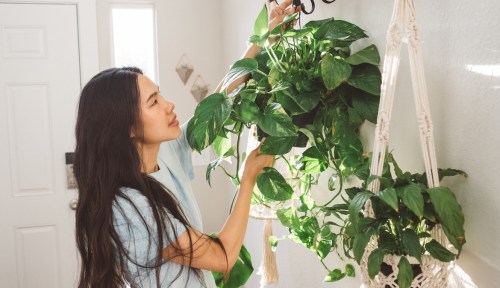Our editors independently select these products. Making a purchase through our links may earn Well+Good a commission
Pothos vs. Philodendron: Which Plant Is the Better Choice for You?
Learn about the differences between pothos and Philodendron plants, plus what makes the two indoor plants similar.

If you want an easy care indoor plant that’s near-impossible to kill, a pothos or Philodendron plant might appeal to you. Both can tolerate low light levels and both thrive in cooler or warmer climes. (If you have pets or small kids, it’s also important to mention that they are potentially harmful if ingested.) They look alike, too. While they share a lot in common, they are two different, if related, house plants. It can be tricky to tell them apart—that is, unless you know what to look for when examining a pothos vs. Philodendron.
Experts in This Article
Caroline Copeland is a design expert at online custom landscape design platform, Yardzen.
plant expert and founder of Greene Piece
plant education coordinator at The Sill
The physical differences between pothos and Philodendron
Many people often mistake pothos for Philodendrons, particularly the Heartleaf Philodendron, and vice-versa, according to plant expert at The Sill Paris Lalicata, though there are tells—like their foliage, for one—that make them distinguishable from one another.
As their name implies, “Heartleaf Philodendrons have more heart-shaped leaves compared to pothos,” says Lalicata, whereas the leaves of a pothos plant resemble “a folded pizza slice.” Caroline Copeland, an online design expert at Yardzen also mentions that Philodendrons feature a prominent arch at the point where the leaf attaches to the stem (aka the petiole), as well as a pointed tip, further lending to its heart-shaped appearance. What pothos leaves have that Philodendron leaves do not is an indented midrib, which is the line that runs down the center of a leaf blade.
The plants’ foliage don’t just look different, they also feel different: “Philodendrons have thinner leaves that are smoother in texture, while pothos have thicker, waxier leaves,” says Lalicata.
You can also distinguish between pothos and Philodendrons when the plants have new growth. “Philodendrons have these cataphylls, also called sheaths,” says Lalicata. “Whenever a new growth comes up, there’s always this little protective sheath that covers the leaf until it unfurls and then starts to decay once it doesn’t have a purpose anymore, which is something that pothos don’t have at all.” She adds that whenever Philodendrons put out new growth, it is reddish in color before turning green, while pothos’ new growth starts out pale green in color and deepens over time.
Lastly, while Pothos and Philodendrons both have aerial roots that supply moisture to the plants while allowing them to scale adjoining objects (like stakes or walls), they look different. According to Lalicata, Philodendrons have thin aerial roots that are grouped together. Conversely, pothos have thick, stubby aerial roots that grow longer if they are trained to climb. In other words: “When you look at a the aerial roots on a pothos, you will see individual little nubs or stubs, whereas when you see the aerial roots on a Philodendron, there are usually two or four clustered together and [the roots] are really thin compared to the Pothos,” she says.
Pothos vs. Philodendron: care and maintenance
For all their physical differences, pothos and philodendrons require similar care. In fact, Lalicata says there’s little to no difference in caring for either of the plants. “Both are considered low-maintenance plants, which means they’re versatile, and they can tolerate lower light conditions,” she says. However, Lalicata and Copeland mention that they will typically prefer brighter light conditions. Additionally, the two plants can withstand normal room humidity for as long as the air isn’t too dry. Usually, their watering requirements are similar, too.
Copeland typically recommends watering them when the top layer of the soil feels dry and dusty. Lalicata likewise recommends letting the soil dry out in the pot between waterings. If in doubt about watering, Lalicata says you can check the moisture of the soil using your finger, a soil moisture meter, or a soil sleuth. “Some people also use the chopstick method,” she says. “Put a chopstick in there and if it’s clean when you pull it out, that means the soil is dry and you can water your plant.” Both, however, are “super resilient plants,” Copeland says. “If you do end up forgetting to water them, there’s a strong chance they will recover.”
All that is to say, whether you’re caring for a pothos or a Philodendron, “they would be in the same category together as far as care and maintenance go,” says Lalicata.
Propagating pothos and Philodendrons
Pothos and Philodendrons don’t have many differences when it comes to propagating them either. Both plants can be propagated by cutting. For the uninitiated, “cutting is the method of taking a piece of a baby plant from the mother plant and reproducing it, plant doctor and consultant Maryah Greene previously told Well+Good. Leafy plants, like pothos and Philodendrons, can be propagated in water, says Lalicata—and the process is simple. Using sanitized pruners, clip a cutting from the node of your plant and place it in a vessel, like a Mason jar or a propagation vase, filled with water. After two to three weeks, or when the roots are about an inch long, you can transfer the cutting in a pot of soil.
Alternatively, Lalicata says that you can leave pothos or Philodendron cuttings in the water indefinitely. “I have several vases of both Philodendron and pothos that I’ve had for many years in water,” she says. “It’s an alternative way to decorate your space with the [plants] and not in soil.”
Sign Up for Our Daily Newsletter
Get all the latest in wellness, trends, food, fitness, beauty, and more delivered right to your inbox.
Got it, you've been added to our email list.








